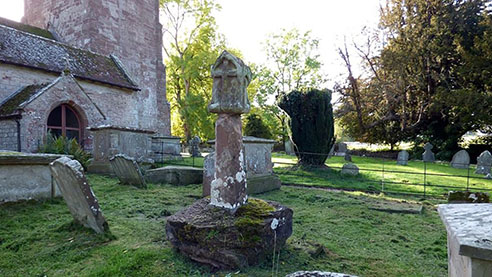Like most English rural churches, St Dubricius is surrounded by a churchyard; which was the burial ground of the parish for centuries. Although the surving stone tombs are of the 17th and 18th century, burials would have started very much earlier. The burials at St Dubricicius seem to extend beyond the present churchyard; certainly to the south, where grave cuts were observed during archaeological work

The churchyard and cross by Sandy Gerrard

a cleaned gravestone
The Book of Llandaff records that Tempore etguardi regis anglie et grifudi regis gualie -'in the time of Edward, King of England and Gryffyd, King of Wales', Bishop Herewald ordained 'Enniaun filium [son of] Cincenn' to 'hennlann dibric'and 'lannteliau in uno cimiterio' [in one cemetery. 'Edward, King of England' is Edward the Confessor who died in January 1066 and 'Gryffyd, King of Wales', is Gruffydd ap Llywelyn, who could probably only be referred to as King of Wales from 1057 until his death in 1063
Bishop Herewald was active in South-East Wales, and is called Bishop of LLandaff in the Book of Llandaff. This is an anachronism, as the see didn't exist as such at the time. In 1055 a peace treaty between Earl Harold Godwinson and Gryffydd was negotiated at Billingsley, several miles to the south of Hentland. This suggests a concession by the English that Hentland was in Wales, athough this remained in dispute for many years.
The old church of Dyfrig 'hennlann dibric' and the Church of Teilio 'lannteliau' in one cemetery strongly suggests the merger of two original foundations with seperate dedications. If the present burial ground is the cemetery referred to, then it existed by the 11th century.
Churchyard crosses are a subset of the large number of medieval stone crosses erected for a range of purposes. There may originally have been more than 12,000 crosses distributed throughout England. Most have disappeared and many of those that remain are now damaged. Near to Hentland, the base of one at Wilton seems to have marked a crossing of the River Wye; another, a wayside cross, gave it's name to the hamlet of St Owen's Cross. Other crosses marked the site of markets. Churchyard crosses seem to have served a variety of functions, defining a sacred space, including for burial prior to the eventually widespread use of individual gravestones, and providing a focus for outdoor liturgical services and processions, particularly on Palm Sunday, and for occasional preaching. The overhelming majority of Herefordshire crosses are in churchyards. In 1930 Afred Watkins published his book,The Old Standing Crosses of Herefordshire, a comprehensive survey and schedule with photographs and description of each cross. Churchyard crosses (as opposed to market, wayside or village crosses) accounted for just over a hundred, a majority, of the total. Of these 43 are now scheduled ancient monuments.
The Hentland stone cross is 14th century. It has been broken, possibly by 17th century Parliamentary soldiers, like the party which left Ross with the intention of destroying the cross at Sellack church. At a later date, the original Hentland gabled head, has been replaced on the broken, shortened shaft. It is very weathered. The Crucifixion is visible on the west gable, while the east is probably the Virgin and child. A bishop, traditionally Dubricius, is on one of the minor sides, and another figure on the fourth.

a cleaned gravestone
A lychgate more specifically defines the edge of the Churchard as a sacred space. The Hentland lychgate is on the north side of the churchyard. Lychgates are rooved gateways found at the entrance to many churchyards. Lychgate takes its name from Old English līc, corpse - as in Lyke Wake. Lychgates mark the boundary between the sacred and the profane. Traditionally corpses were carried by friends and family to the lychgate, where they were placed on a bier to await the priest, who took charge in consecrated ground. As at Hentland, seats were often provided at each side of the structure for the bearers to rest while they waited
The Hentland lychgate is by J P Seddon, and was restored in the 1940s.